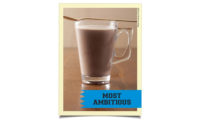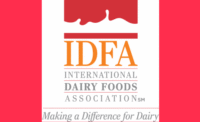
Out of The (Ice) Box
With a range of stringent processing requirements,
aseptic packaging remains a slow mover in the cold-based U.S. market.
by Lynn Petrak
Shelf appeal has always gotten a lot of
attention from dairy manufacturers and marketers, but these days,
it’s being interpreted in a novel way.
Shelf-stable dairy products, once the stuff of
21st century predictions or thought of as relegated to cold
chain-challenged parts of the world, are slowly making their way out of
refrigerators in this country.
To be sure, the emphasis is on slow —
there is no rapid change in the way dairy products are produced and
distributed in the United States and it’s not likely the average mom
will open the pantry door to serve her kids milk from an ambient bulk
container.
That said, there have been breakthrough concepts
and potentially effective and profitable areas for aseptic packages of
various dairy and dairy-based foods and beverages. “The way to think
about it is that it is a very specialized application. While applications
are getting broader and more mainstream, aseptic packaging will never
replace the gallon jug. Its role is to do things the gallon jug can’t
do,” says Jeff Keller, vice president of strategic business
development for Tetra Pak, Vernon Hills, Ill., a supplier of packaging
materials for dairy, including aseptic capabilities. “Aseptic
packaging adds value, improves flavor in certain products and improves
supply chain economics of many systems.”
The aseptic process is decidedly different from
traditional production and packaging of perishable foods like dairy
products. First, and probably foremost, aseptic processing sterilizes a
food or beverage product by destroying potentially harmful microorganisms
by a stringently controlled thermal process, also known as flash or
ultra-high-temperature (UHT) pasteurization. All products must then be
conveyed a sterile (think operating room) environment to be placed in a
sterile package. The packaging material itself is a critical aspect of
aseptic technology, since it is the barrier between production and end use.
As Keller points out, aseptic processing and
accompanying packaging technology can impart several benefits to a product
and, in turn, to a processor. In addition to long-term shelf stability and
food safety attributes, aseptic technology also can produce items of
improved sensory quality, enhance nutrient retention and allow for a more
versatile use of containers that range in material type and design.
The Arlington, Va.-based Aseptic Packaging
Council, for its part, promotes the fact that aseptic packages tend to be
energy efficient and recyclable as well as convenient and appealing to
consumers leery of added preservatives in their food and drinks.
Many industries have utilized the technology for
years, in fact. Aseptic packages are used for a wide variety of food and
beverage items in the United States, including soy-based drinks, infant
formula, tomato sauce and liquid eggs.
For all of the advantages, though, there has
been at best a gradual expansion of aseptic processing into the dairy
category. “One thing holding back the aseptic market is cold-chain
distribution in this country, which is rock solid. That makes it a
challenge,” says Christopher Hoemeke, who works in business
development for filling equipment supplier Sidel Inc., Norcross, Ga.,
noting such systems also require a significant capital investment.
Such barriers don’t mean there
aren’t windows of opportunity opening for the movement of aseptic
products through new or even existing distribution channels. “One
thing that could really change it is the rising cost of
transportation,” Hoemeke says.
In addition, the creative use of aseptic formats
in Europe, Asia and even South America, where they are now flourishing, may
also cause U.S. processors to take note of some trends and possible
applications here. “If you travel in Europe, aseptic packaging is
more common. Although that level of acceptance has yet to be realized in
this country, I think there is potential based on the European
experience,” says Paul Burdick, director of marketing and sales for
Schneider Packaging Equipment Co. Inc., Brewerton, N.Y., which
supplies various packaging systems for traditional as well as aseptic
purposes.
Brick by Brick
Currently, one of the most common formats for
dairy-based aseptic products is the multi-layered, high-barrier carton,
also known as a drink box or brick package. Tetra Pak is a leading supplier
of this type of package, supplying Tetra Brik and Tetra Prisma® packages
for single-serve consumption.
The Tetra Prisma was first used to a national
extent in the dairy market by Longmont, Colo.-based Horizon Organic for
shelf-stable, single-serve flavored milks. Launched nearly three years ago,
the milks became popular grab-and-go items at nationwide Starbucks Coffee
stores as well as in natural food stores, club stores and eventually in
mainstream supermarkets, where they are now also available in multi-packs.
Although usually merchandised in the
refrigerated section, the shelf-stable format helped operators add value to
their business by easier storage and distribution. In another way, the
visibility of such products introduced many Americans to the concept of
fluid milk that did not require refrigeration.
On the heels of Horizon Organic’s success,
Bravo Foods International, North Palm Beach, Fla., also chose the Tetra
Prisma package for one format for its line of Slammers flavored milk
products geared to kids. In addition to plastic bottles with ESL products,
Bravo has opted for shelf-stable milk as another option for those in its
distribution channel. Both the bottle and the 11.2-ounce aseptic carton
feature nearly identical colors and graphics, including the use of licensed
Marvel® superhero figures.
More recently, Tetra Pak has supplied Prisma
aseptic cartons to ESE Dairies, a subsidiary of East Side Entrees,
Woodbury, N.Y. A major supplier of more than 3,000 school districts around
the country, ESE wanted a package that would encourage children to drink
more milk and that didn’t require refrigeration. ESE’s Prisma
packages of flavored milks and milkshakes, under the Shake ’n’
Sip brand, feature characters from popular Nickelodeon cartoons, such as
SpongeBob SquarePants and Jimmy Neutron.
School vending is a logical extension of the
brick package, and one Tetra Pak is pursuing in other avenues as well.
Schools can especially benefit from the shelf stability of milk products,
as the company points out, because such packages help ensure food safety
while cutting down on spoilage and waste.
Along with school-based programs, Keller
believes the next generation of Prisma packages could emerge in other
aspects of foodservice. “Another area of development for milk and
flavored milk is through quick-service restaurants. We think there is a
real opportunity in that channel for aseptic milk for kids,” he says,
adding that the recent switch to from cartons to plastic single-serve
bottles at chains like McDonald’s and Wendy’s may result in an
interest in milk drinks with even longer shelf lives or those that offer
shelf storage. “As you look as supply chain issues and benefits,
you’ll find key opportunities for aseptic flavored milk because they
can provide variety you may not be able to provide with pasteurized
[products].”
Whether sold through retail or foodservice
outlets, another advantage of aseptic cartons is the potential size and
shape variation. Schneider, for example, recently helped Stamford,
Conn.-based Mott’s Inc. bring production of its shelf stable Yoo-Hoo
drink boxes in house, as the company wanted a different look in its
packaging format. The Tetra Brik packages were slimmed down to better fit
young consumers’ hands, which also allowed Mott’s to increase
the number of drink boxes placed in multi-packs. Schneider provided the
plant’s new custom packaging line, including supplying a conveyor
feed, multi-packer and tray packer.
According to Burdick, the system for aseptic
Briks has actually proven more user friendly than some traditionally
packaged products. “On the aseptic side, it’s one of the
simpler applications we have. It’s single tier and we don’t
have a lot of layering involved, for example,” he explains.
Beyond the Carton
Aseptic drink boxes may have generated a lot of
interest in recent years for their various attributes, but there are other
types of containers that work well with aseptically processed dairy
products. For example, the shelf-stable Raging Cow dairy-based drink,
a product of Dr Pepper/Seven Up, Plano, Texas, has been packaged in a
high-density polyethylene (HDPE) bottle that is aseptically filled on a
Tetra Pak system.
The aseptically filled bottle, in fact, may be a
focus of other milk processors, who continue to tinker with the shelf life
of their products. Already, dairies like Orrville, Ohio-based Smith Dairy
have developed ways to sell flavored milks with a 60-day referigered shelf
life in a polyethylene terephthalate (PET) bottle, packaged using a sterile
filler.
Pouches are another type of material used for
dairy products manufactured under aseptic conditions. Among its line of
films, Wilmington, Del.-based DuPont Packaging, for example, offers an
Enhance aseptic pouch. Designed to protect a sterile product from
outside contamination, pouches made with Enhance film are commonly used in
foodservice settings and chosen for their safety, shelf life, storage
capability, less packaging waste and elimination of the use of additives.
Tetra Pak, too, supplies pouches, including a
traditional Tetra Wedge Aseptic pouch and its latest offering, the Tetra
Wedge Aseptic Clear pouch. “I believe the Aseptic Clear has some
exceptional dairy opportunities, for products like flavored milks,
drinkable puddings and smoothies. It allows for transparent printing
technology that maximizes printing clarity and impact,” Keller says.
Applications for both types of Tetra Pak Wedge
pouches include dairy products, such as bases used by foodservice operators
and ice cream bases sold to consumers through gourmet stores and catalogs.
Meanwhile, along with the container itself,
aseptic packages feature an increasing array of bells and whistles these
days, or at least more advanced accessories. The Tetra Prisma, for
instance, is often packaged with a glued-on straw, especially engineered
for the products’ main consumers, children. In addition, Tetra Pack
now offers a screw cap option for its 12-ounce, 16-ounce and quart Brik
packages.
In the area of foodservice and bulk containers, there
have been other types of enhancements in aseptic package features.
International Dispensing Corp., Hanover, Md., for example, recently
commercialized the world’s only gravity flow valve (GFV), designed to
allow liquid products to be dispensed from a flexible bag or pouch without
oxygen or bacteria entering the package. The valve’s first commercial
applications include dairy and ready-to-drink coffee beverages.
Equipped for Success
The vessel is usually the main focus of aseptic
packaging technology, but the equipment on which it is run is also crucial.
Improvements have been made in several areas of aseptic machinery, from
aseptic fillers to conveyor systems to loaders and palletizers.
Sidel’s R&D team, for example,
detected a need for more efficient filling systems for ESL and aseptic
products. “The missing element on these lines has been line design
and line engineering. Everyone is focusing so much on the filler itself and
forgets how much an improperly designed line can bring you down,”
Hoemeke says. “If downstream isn’t running, neither is your
expensive filler.”
To help ensure a properly designed system, Sidel
works with dairies to incorporate its integrated blowing, filling and
capping systems with other machines on the line for greater consistency and
efficiency. Among other features for aseptic purposes, Sidel’s
systems allow for fill volume to be controlled by electromagnetic commands
of the filling nozzle. The machinery also has been engineered to reduce
labor, because contamination sources are most likely to be equipment
operators at that stage of production.
Further down the line, Schneider has focused on speed and efficiency
for aseptic packaging as well. The company’s latest TP-35 Tray Packer
model for aseptic cartons is capable of running 200 ml to 1.5 liter aseptic
cartons at a rate of up to 25 trays a minute. Schneider’s MP-20 Multi-Packer/Bundler
then takes single products like aseptic cartons, collates them into a bundle
and shrink-wraps them. Both systems, says Burdick, are designed for sanitation,
which is key in any processing environment, much less an aseptic one. “The
equipment is all stainless steel for washdown,” he says. df
Lynn Petrak is a freelance journalist based in the Chicago area.
$OMN_arttitle="Out of The (Ice) Box";?>Lynn Petrak is a freelance journalist based in the Chicago area.


